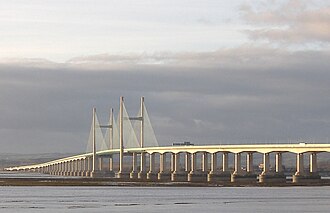Second Severn Crossing
| Second Severn Crossing | |
|---|---|

The Second Severn Crossing, viewed from Severn Beach
|
|
| Coordinates | 51°34′28″N 2°42′06″W / 51.5745°N 2.7016°WCoordinates: 51°34′28″N 2°42′06″W / 51.5745°N 2.7016°W |
| Carries | 6 lane M4 motorway |
| Crosses | River Severn |
| Locale | South West England/South East Wales |
| Characteristics | |
| Design | Central span: Cable-stayed bridge Approach viaducts: Segmental bridge |
| Total length | 5,128 metres (16,824 ft) |
| Width | 34.6 metres (113.5 ft) |
| Height | 137 metres (449 ft) |
| Longest span | 456 metres (1,496 ft) |
| Clearance below | 37 metres (121 ft) |
| History | |
| Opened | 5 June 1996 |
| Statistics | |
| Toll | Car: £6.70 Van: £13.40 HGV: £20.00 Motorcycle: Free Disabled badge holder: Free |
The Second Severn Crossing (Welsh: Ail Groesfan Hafren) is the M4 motorway bridge over the River Severn between England and Wales, inaugurated on 5 June 1996 by HRH The Prince of Wales to supplement the traffic capacity of the original Severn Bridge built in 1966. The bridge marks the lower limit of the River Severn and the start of the Severn Estuary.
It is further south than the old bridge; as it is closer in line with the landward sides of the M4, it gives a shorter journey when travelling between England and South Wales. The junctions at each end are designed for most traffic to use this crossing, and in order to use the old Severn Bridge crossing, one has to leave the M4 and join the M48 either at Aust or near Magor. The new crossing carries more traffic than the Severn Bridge, which is still in use. It is much wider than the Severn Bridge, having three lanes and a narrow hard shoulder each way, compared to the two lanes, cycle path and narrow footpath of the original crossing. The path taken by the bridge is close to that of the Severn Tunnel, which has carried the railway line beneath the river bed since 1886.
Much of the estuary is mudflats at low tide, but at high tide these can be covered by as much as 14 metres (46 ft) of water. This presented the engineers with a constraint: packets of work were scheduled at low tide, and needed to be completed within the short windows allowed by the tides.
The concession given to the consortium which financed, built and operate the bridge required them to take over the outstanding debt on the original Severn Bridge and to operate the two bridges as a single entity. Tolls are set annually by the government based on the previous year's change in the Retail Price Index. On the expiry of the concession the consortium is required to hand the bridge over to public ownership. It was reported in 2012 that the repayments were likely to continue until the early 2020s due to the introduction of a revised settlement to the operator in return for accepting payment by debit and credit cards. The announcement said that even after repayment was complete the toll charges would likely remain at the same levels.
...
Wikipedia
